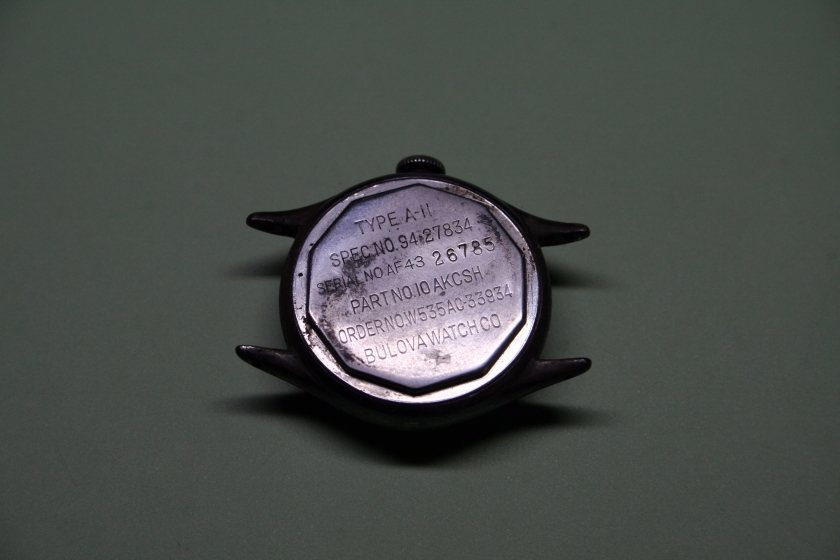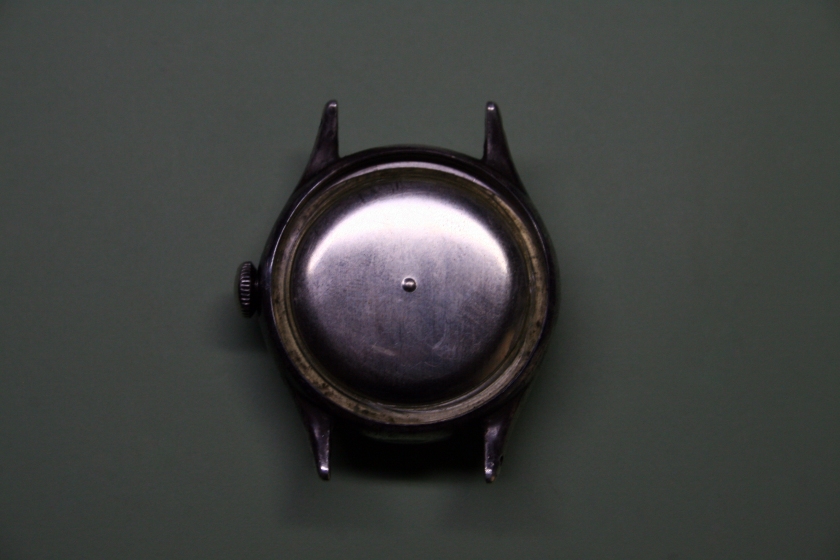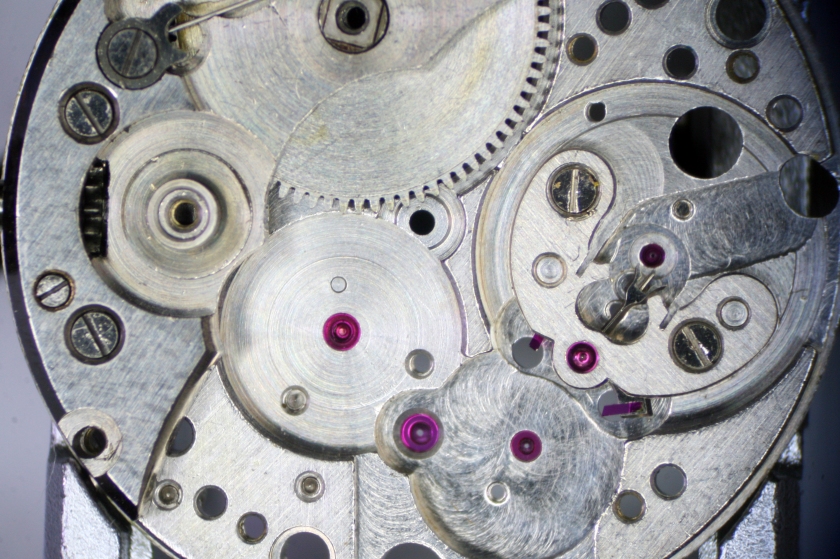I wasn’t actually in the market for another timepiece when I stumbled upon this one. I have a habit (a bad one) of perusing websites where vintage watches may turn up at a price point that tickles my fancy. This can be a problem when I have little money in my pocket but sometimes I’ll find a watch that I really cannot pass up and in the case of this fine watch I feel I had no option other than to make the purchase.
The watch is a Bulova 10AKCSH, better known as the A-11. The name A-11 is derived from the specification that pertains to watches ordered by the United States Army Air Corps during the second world war; watches under this spec were produced by Bulova, Waltham Watch Co., and Elgin National National Watch Co. (you can read a bit more about their history here). The timepieces were American made to support the war effort. It seems the watches were issued to officers and flight crews of the Army Air Corps.
Unfortunately my watch was in rough condition but it appeared to have had only one or two owners. This is something that is important to me as a watch that has changed hands many times is more likely to have hidden gremlins inside.

I thought all A-11 watches were cased in nickel plated brass but after receiving my purchase in the mail I discovered that this particular piece is cased in solid silver. This pleased me greatly as nickel cases often develop unsightly pitting over time silver, on the other hand, may tarnish but that tarnish will actually protect the remaining silver underneath.
The crystal was heavily scratched and had a small crack at the bottom. The watch ran but not well. Sometimes it would run for an hour and sometimes it would run for a few minutes. A service was definitely in order.
I began my work by removing the bracelet and setting this aside. My wife, who was in the service, noted that the bracelet appears a bit like a military memorial bracelet.
On the caseback I found engraved text that cleared any doubt of watch’s origin. The serial number indicates it was manufactured in 1943 under government contract.

The A-11 has some special features that were not often found on other timepieces of the same period. First, it’s water resistant. The caseback is threaded and there are gaskets beneath the crystal, inside the stem tube, and under the caseback. Second, the watch has a hacking feature. This feature is pretty common today (as is water resistance) but was not as common in 1943. The hack works thusly- a lever is engaged within the watch, when the crown is pulled out to the setting position, which stops the motion of the balance. This in turn stops the watch and allows you to set the time quite precisely (to the second).
Removing the caseback exposes a dust cover which also protects the movement. This is a nice touch. It’s clear the Army understood what these watches were going to be put through.

Unfortunately despite the gaskets and dust cover there was quite a bit of debris inside the movement. I’m sure it would have been worse without these protective measures though. Happily the movement is entirely rust free!

At this point all that is needed to free the movement from the case is the removal of the crown and stem. No longer hidden behind the crystal I could see the dial and hands were in good shape. The dial had some small spots on it and the paint had cracked on the hands where they mounted to the post but all in all I was quite pleased.

Close examination of the movement revealed the watch was severely over lubricated. Oil had pooled on the gears and attracted debris.

Oil had also pooled heavily beneath the dial. I was lucky the oil hadn’t migrated topside and severely damaged the dial paint.

I began disassembly by removing the hacking lever from the dial side. I usually take the balance cock off first but in this case I didn’t want to risk the balance getting caught up on the hacking lever.

With the lever removed I started disassembly on the train side.

Other than parts sticking to my tweezers from excess oil, the breakdown was uneventful.



I thought there might be an issue with the mainspring as the watch could never meet full wind. It turns out I was correct.

Once completely broken down, the parts were sent to the cleaning machine and a new mainspring was ordered. I also ordered a complete balance as I had “a moment” with the hairspring when I removed the balance from the balance cock. Turns out I was a bit overly cautious in this regard as my hairspring straightening skills are much improved.
The “new” mainspring arrived and I set about rebuilding the Bulova.




Assembly was fast and furious and by that I mean it took roughly twice as long as disassembly. Still, since this is a typical watch movement and not a chronograph, assembly was a breeze.
The reading on the timegrapher before positional adjustment was encouraging.



The gasket that sits beneath the crystal had broken apart when I removed the old crystal. As a result I needed to order a replacement. I don’t have much faith in the water resistance of a seventy-three year old watch but the crystal would not have sat right without a new gasket.

I opted not to polish the case or caseback as I find the patina of both to be pleasing. This is a watch that’s been through a lot and it should wear any scars proudly.

Lastly, I added a simple olive drab strap to complete the service. I’m quite pleased with the result.

The watch now keeps fair time and looks quite fetching too.
Postscript
I brought the watch to my grandmother shortly after receiving it in the post. I wanted to know if my grandfather, who served in the war, may have been issued an identical timepiece. My grandfather, Lauri Ruha, was a pilot in the 456th Bomb Group, 747th squadron, which flew missions out of Stonara Italy (thanks to the 456th Bomb Group Association and the Internet Archive first person accounts from the crew he served with are preserved here). Of course my grandmother recognized the watch straight away and confirmed he was issued one just like it. As she says, it was his favored watch because it kept impeccable time whether he was at sea level or at 25,000 feet.



Probably one of my favorite blogs! This one turned out ‘spot on’!
LikeLike
Great watch, great job, great story! Thank you very much for sharing.
I am currently working on an A11 as well and I am disassambling the movement currently.
One question, if you dont mind: How does the cock for the center second pinion come off? Just remove the one screw visible? The two visible pins left and right of the screw are just positioning pins? I am guessing but dont want to break anything. The cock is pretty tight after having removed the screw….
And a good source for spare parts would be good as I am searching for a new setting lever spring. Unfortunately the one in my watch is broken.
Best regards,
Carsten
LikeLike
I have one of these watches. I think mine also has a silver alloy case, as even though all the nickel plating is worn away, the case is still in excellent condition, and is still white, rather than yellow metal. The dial is in about the same condition as the one seen here, and the hands are a little less yellowed with age. The watch keeps very accurate time too — a little better than most mechanical watches I think. It really is an excellent timepiece, and it’s my favorite watch, out of the several that I own.
LikeLike
A good watch with a lot of history- hold on to it!
LikeLike
Wonderful write up and thank you for sharing. I have a soft spot for the Bulova A-11 and A-15 watches of WW2. I hope to own one as nice as yours someday. In the meantime I have been wearing a modern A-11 Bulova released a few years ago. It was known as the Military UHF model 96B230 and has the impressive 262kHz movement.
LikeLike
Thanks for the details on your A-11. Great history lesson on the squadron. I have a
Bulova A-11 Serial AF42-1214. The case back looks inscribed with the MilSpec information and not stamped as I have seen else here. Any thoughts? My father was a collector of watches and that’s how he acquired the watch. He did serve in the USN during The Korean War as a medical corpsman on a hospital ship converted from an aircraft carrier the USS Cape Esperance.
LikeLike
I just purchased a very similar watch, where did you find the crystal and gasket?
LikeLike
Hi Thomas,
I usually get replacement crystals from either Jules Borel or Esslinger as both companies are located in the US and therefore have lower shipping costs.
LikeLike
Great story. Can you share the specific replacement crystal that you purchased? Thanks!
LikeLike
A very interesting story.. history.. heritage ..a vintage watch..
LikeLike